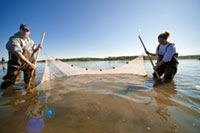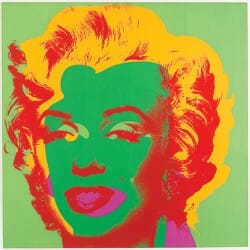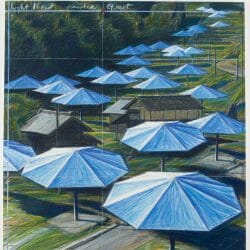A Semester at the Museum
Students learn that behind every successful collection is essential hands-on work.

Sifting and winnowing: students use a large net to collect aquatic samples at Madison’s Lake Wingra. The students were learning how to collect field samples — in this case small fish — for later preservation. Photo: Bryce Richter.
On such a perfect fall day — sapphire blue sky, just the faintest hint of crispness in the air — perhaps it is no surprise that a group of students is lingering at the edge of Lake Wingra rather than sitting in a classroom.
But these fifteen or so young men and women aren’t playing hooky. Clad in waders, they take turns in pairs, venturing into the soft muck offshore to pull a seine through the water. As each team hauls in the net, the other students gather around to inspect the catch — bluegill, yellow perch, a disgruntled-looking crayfish.
How do you get credit for going fishing?
Zoology 400: Introduction to Museum Studies brings the what, why, and how of museum specimens to life through a mix of lectures, labs, field trips, and visits to six campus museums and collections, including the UW Zoological Museum, the Wisconsin State Herbarium (see page 18), and the UW Geology Museum.
“Museums have a really important yet unrecognized role,” says Mark Berres PhD’03, an animal studies assistant professor. “The perception is that this is just a bunch of antiquated things. Nothing could be further from the truth. … We can make very good use of this material in cutting-edge science.”
The course focuses on natural history museums and their evolving roles in research, instruction, and public enjoyment, though many of the concepts also apply to humanities and art collections. The students gain insight into administrative protocols of accession, cataloging, and conservation, as well as the how-to of proper specimen collection and preservation. In addition to netting fish, they gather and press plants, pin insects, assemble skeletons, and preserve soft tissues, all within the context of the historical, contemporary, and potential future uses of museum collections.
The hands-on work is an essential element, Berres says. “It’s the next step in [the students’] education to go beyond simply being a passive reader about what needs to be done, to actually physically doing it. And being able to translate that theory into practice really creates a spark in a lot of students.” Many students complete an optional internship at a campus museum for an additional credit.
The course was immediately popular when Berres and UW Zoological Museum staff first offered it in 2008 with strong cooperation from other campus museums. The class format limits its size, and registration quickly overflows to a waiting list. It appeals to a mix of majors, attracting students in zoology and other biological fields, anthropology, and history of science.
As the students learn about various preparation and storage methods required for different purposes — one for keeping a specimen’s shape, another for preserving its DNA, for example — they come to appreciate the challenges involved in maintaining an object’s long-term value without knowing exactly how it will be used.
“To be honest, I really hadn’t thought before about what goes into it,” admits zoology major David Parfitt x’10, his jeans still damp from his own foray into Wingra in slightly leaky waders.
As new analytical techniques are developed, many museum pieces are being used in ways that could not have been anticipated when they were first collected, Berres says. Today, for example, archived specimens are routinely used for DNA studies, which were rare a few decades ago. Other collections have guided recent studies of environmental pollution and even climate change.
“The technology changes so much. Who knows what these samples could actually be used for in the future?” he muses. “The science fiction of today is the reality of a very soon tomorrow.”
Published in the Summer 2010 issue



Comments
No comments posted yet.